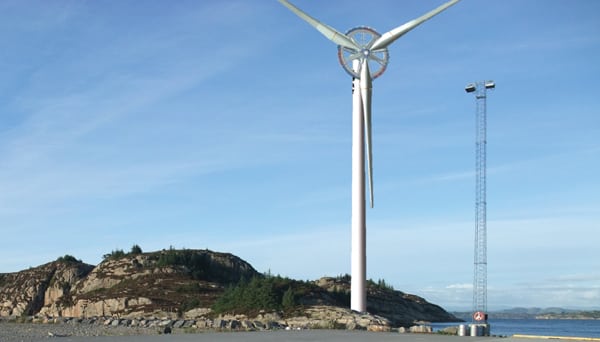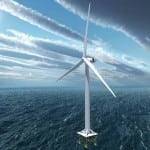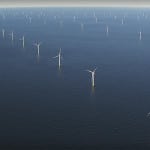Offshore wind turbine technology experienced a brief gust in October as Siemens Energy began field testing of its new 154-meter (m) rotor for the 6-MW offshore wind turbine, and Norwegian technology company Sway Turbine unveiled a 10-MW offshore turbine.
Siemens began field testing of what it claims is the world’s largest rotor blade, the 154-m B75, in Østerild, Denmark, on its SWT-6.0-154 direct-drive wind turbine (Figure 3). The first Siemens 6-MW turbine was installed in May 2011 at the Høvsore test site in Denmark, but due to height restrictions, a 120-m rotor was used on the prototype. The serial version of the 6-MW turbine will use the 154-m rotor and is expected to become the new benchmark in the offshore wind industry, Siemens said.
 |
| 3. Size matters. Siemens began field testing of what it claims is the world’s largest rotor blade, the 154-meter B75, on its SWT-6.0-154 direct-drive wind turbine in Østerild, Denmark, this October. Courtesy: Siemens |
The company has so far procured an agreement with Denmark’s DONG Energy for 300 of the 6-MW turbines for use in projects off the coast of the UK. Siemens is expected to install two more SWT-6.0 prototypes in the UK Gunfleet Sands project, marking the first time that the Siemens 6-MW wind turbine will be tested offshore. Both turbines for that project will be equipped with the 120-m rotor.
In October, meanwhile, Sway Turbine unveiled its much-awaited ST10, a 10-MW model that “offers an estimated 15–20% reduction in turbine cost compared to current state of the art, conventional design offshore wind turbines, and a considerable reduction in cost per kWh produced on wind park level,” the company said in a recent presentation.
To meet the challenges of scaling up the turbine, Sway said it embarked on several “unusual design solutions” (Figure 4). Designed for harsh conditions, basic specifications include a 164-m rotor diameter with three rotor blade supports, a 13 m/s rated wind speed, and 12 rpm nominal speed. The turbine does not have a rotor hub; it instead features an open generator, which looks like a bicycle wheel. Each of the three pitching blades is mounted to an “A-frame” blade support structure that straddles the generator. The support structure legs terminate on two independent hubs, which also function as the hubs for the generator rotor. The outer rim of the generator rotor is connected to the blade support structure, providing the means of transferring torque between the turbine rotor and the generator. Designed to operate upwind on a fixed tower, the turbine has a design life of 20 years.
 |
| 4. A turbine titan. Norwegian company Sway Turbine in October unveiled details about its 10-MW wind turbine, a machine that features a 164-m rotor diameter with three rotor blade supports. The turbine does not have a rotor hub; it instead features an open generator, which looks like a bicycle wheel. Courtesy: Sway Turbine |
According to the company, the “new combination of components results in a system that has a significant decrease in weight over conventional designs, and a net lower cost of energy.” Sway Turbine is now in the process of identifying “the best industrial partner” to bring the product to the market, it said.
The two project developments are especially welcome after a period in which production of new offshore turbines has lapsed. After brisk progress that saw as many as 1,503 fully grid-connected offshore wind turbines—a total of more than 4 GW—installed worldwide as of June 2012, development of new offshore wind farms has been caught in headwinds, reportedly owing to a crunch on investment in the sector. After receiving the major order in July for 300 6-MW turbines from Denmark’s DONG Energy, Siemens hasn’t taken another order.
Meanwhile, neither Denmark’s Vestas nor Repower Systems, a German subsidiary of India’s Suzlon, has reportedly had an order since October 2011, reported the Financial Times in November. At the same time, the Danish government moved to push back power production from two offshore wind farms with a joint capacity of 1 GW by one year, to 2018, and DONG Energy shelved a project for 96 turbines on a North Sea wind farm off the coast of Germany, cancelling an order for 97 Siemens turbines.
The European Wind Energy Association told POWER that the “pipeline of future deals [for offshore wind power] continues to be strong, with further transactions standing a good chance of closing before the end of the year.” New projects include the completed Walney project in the UK (see p. 42) as well as Butendiek in Germany, and others anticipated in 2013, such as the Gode Wind and Nordergrunde in Germany.
—Sonal Patel is POWER’s senior writer.










